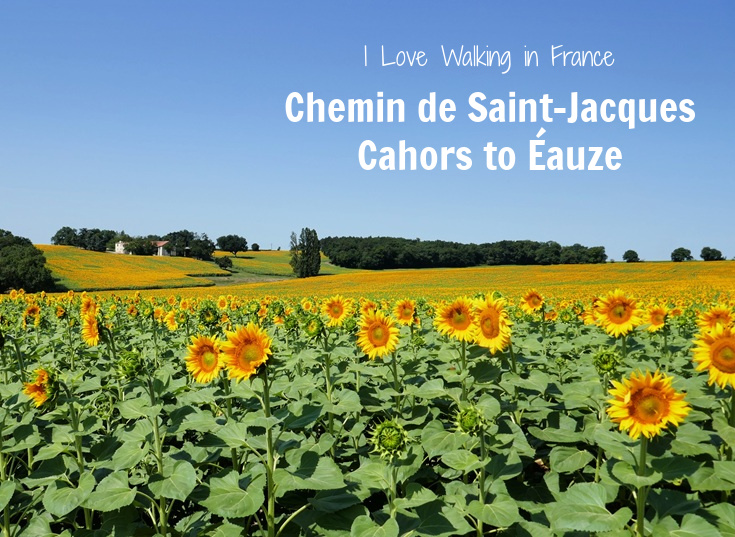
(Published August 2016, last updated June 2025)
From Cahors to Éauze, the GR 65 Chemin de Saint-Jacques meanders through 193.3 kilometres (120.8 miles) of mostly gentle terrain.
On this walk, you will climb a few gorges and follow some shady paths through the forest, but for much of the way you’ll find yourself surrounded by rolling hills and a patchwork of cultivated farmland. Tucked among those rolling hills are vast fields of sunflowers, and in summer, swathes of dancing yellow faces will keep you company throughout the day.
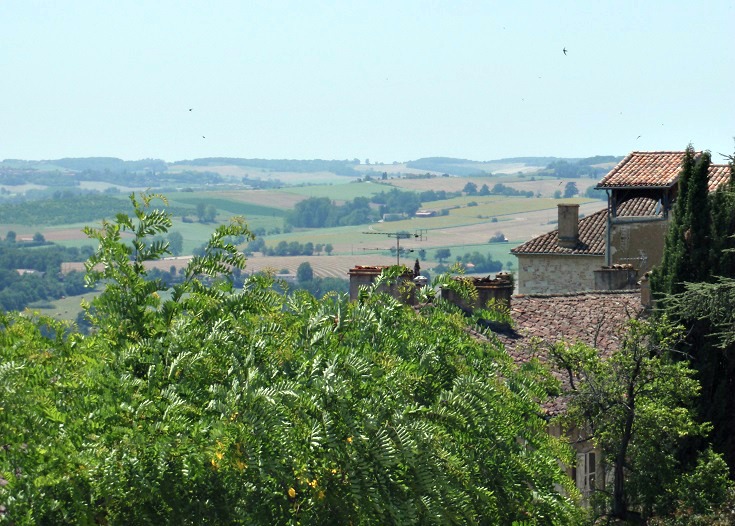
The fortified town of Lectoure occupies a commanding position high on a ridge, with views over the countryside
Medieval splendour is on display here in this south-west corner of France. Over the last thousand years, several of the larger towns were once home to ruling noble families and have played important roles in the area’s history.
Fortified bastide villages and towns occupy prominent positions on the ridges that separate the wide valleys—perfect locations for guarding against invading armies—and it’s not difficult to imagine the battles that were fought here long ago. Although most of the châteaux and fortified walls were damaged during the Hundred Years War and the Wars of Religion in the fifteenth and sixteenth centuries, you will still see grand cathedrals and stone and timbered houses throughout your walk.
Many of the villages you’ll pass through on this route are very small—barely larger than a cluster of houses—but several are worthy of a longer visit. Montcuq, Lauzerte, Moissac, Auvillar, Lectoure, La Romieu, Condom, Larressingle and Montréal-du-Gers all offer quaint side streets, ancient timbered houses, medieval halles (markets),—and sometimes a tower to climb—all enticing you away from the path for an hour or so.
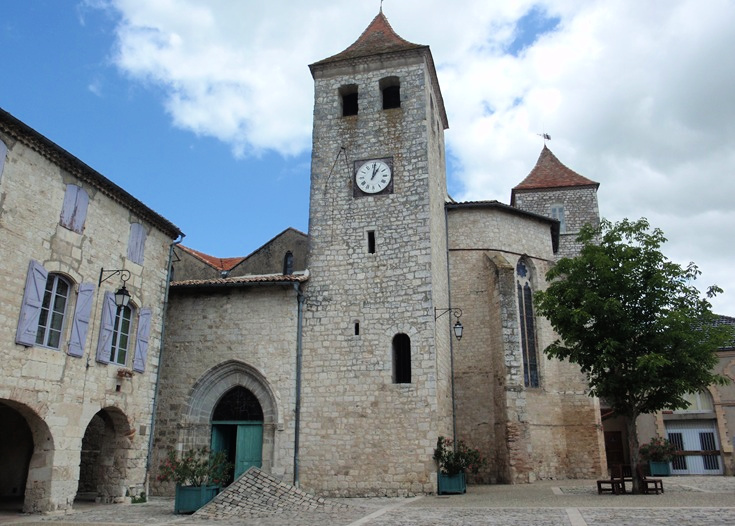
The main square of Lauzerte features an unusual curl in the paving near the church
Look inside the CHEMIN DE SAINT-JACQUES DU-PUY (PDF) guidebook
Where is the Chemin de Saint-Jacques in France?

Map of the Chemin de Saint-Jacques from Cahors to Éauze
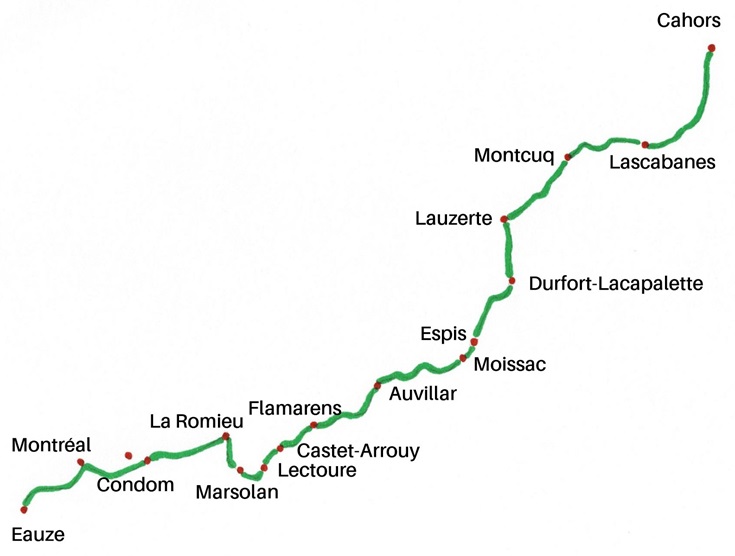
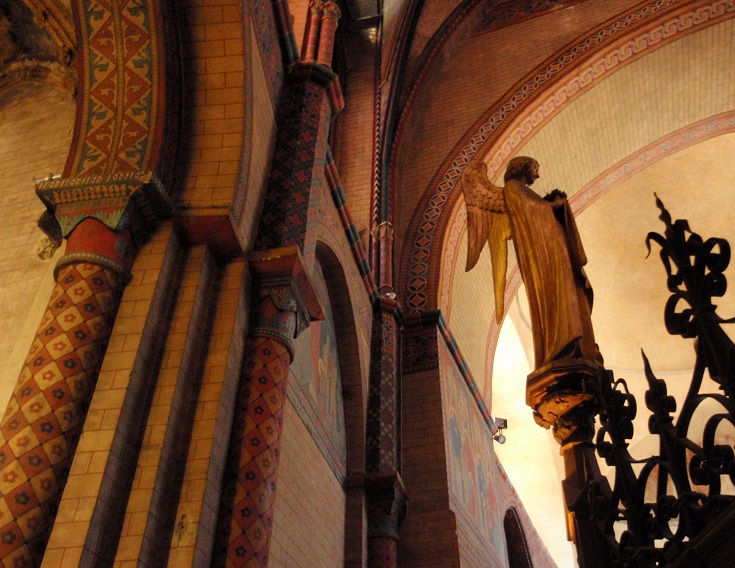
The richly coloured interior of Eglise Saint-Etienne, Cahors
Accommodation along the Chemin de Saint-Jacques from Cahors to Éauze
Accommodation on or very close to the path is available in the following towns.
Distances are given from the starting point of Le Puy-en-Velay (and assume the shorter, traditional GR 65 path has been followed between Figeac and Cahors).
If you have followed my suggested itinerary along the Célé valley, you’ll have covered 359.7 kilometres (224.8 miles) when you reach Cahors.
338.8 km (211.8 mi) Cahors
353.5 km (220.9 mi) Trigodina
363.3 km (227.1 mi) Lascabanes
369.9 km (231.2 mi) Le Bousquet
372.8 km (233 mi) Montcuq
386.8 km (241.8 mi) Lauzerte
394.6 km (246.6 mi) Parry
395.1 km (246.9 mi) Fabel Haut
399.3 km (249.6 mi) Durfort-Lacapelette
403.1 km (251.9 mi) Saint-Martin
410.1 km (256.3 mi) Espis
413.8 km (258.6 mi) Moissac
433.3 km (270.8 mi) Espalais
434.8 km (271.8 mi) Auvillar
438.6 km (274.2 mi) Bardigues
443.6 km (277.3 mi) Saint-Antoine
445.1 km (278.2 mi) Villeneuve
448.1 km (280.1 mi) Flamarens
452.1 km (282.6 mi) Miradoux
457.1 km (285.7 mi) Castet-Arrouy
467.1 km (291.9 mi) Lectoure
472.1 km (295.1 mi) Espasot
476.1 km (297.6 mi) Marsolan
477.1 km (298.2 mi) Mieucas (450m from the path)
486.1 km (303.8 mi) La Romieu
491.1 km (306.9 mi) Castelnau-sur-l’Auvignon
499.1 km (311.9 mi) Condom
504.1 km (315.1 mi) Larressingle (1km from the path)
510.5 km (319.1 mi) Lasserre de Haut
516.1 km (322.6 mi) Montréal-du-Gers
525.1 km (328.2 mi) Lamothe
527.9 km (329.9 mi) Le Coupé
532.1 km (332.6 mi) Éauze
How to book accommodation in French
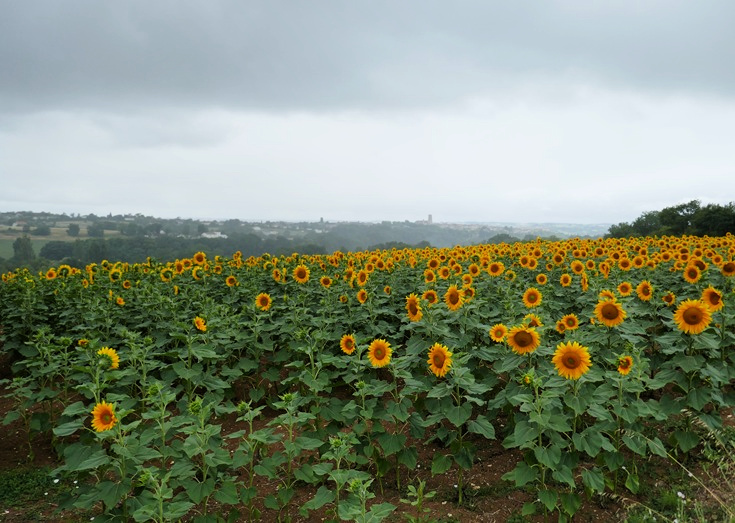
A field of cheerful sunflowers brightens an otherwise gloomy day (photo taken between Castet-Arrouy and Lectoure at the end of June)
Itineraries for Cahors to Éauze
As you plan your walk, remember that there are no set stages and you are free to walk as far or as little each day as you wish. Guidebooks (mine included) are often organised around a list of villages or towns but there is no advantage or obligation to follow these suggestions if the distances do not suit you.
If your preference, or an injury, dictates that no more than ten kilometres (six miles) each day is best for you, listen to your intuition and plan accordingly. On the other hand, if you know you can comfortably walk 25 or more kilometres (15 miles) each day, plan a more strenuous schedule that meets your needs.
I often build a rest day into my walking schedule and if you do too, then Cahors and Moissac are both good choices. But for this section of the Chemin de Saint-Jacques du-Puy I have paced the journey slowly over eleven days, so that none are exceptionally long or tiring.
Many walkers walk from Lauzerte to Moissac in one day (27 km/16.9 mi) but it is quite hilly in places and I like to break this day in two. I choose to spend the night at the gîte in Espis which leaves a very short 3.7 kilometre (2.3 mile) walk into Moissac the following morning—practically a rest day! You could, of course, break this section more evenly at any of the villages listed above.

Le Nid des Anges, a popular stop for the first night in Lascabanes
Eleven-day itinerary for Cahors to Éauze
Day 1 Cahors to Lascabanes (24.5 km/15.3 mi)
Day 2 Lascabanes to Lauzerte (23.5 km/14.7 mi)
Day 3 Lauzerte to Espis (23.3 km/14.6 mi)
Day 4 Espis to Moissac (3.7 km/2.3 mi)
Day 5 Moissac to Auvillar (21 km/13.1 mi)
Day 6 Auvillar to Flamarens (13.3 km/8.3 mi)
Day 7 Flamarens to Lectoure (19 km/11.9 mi)
Day 8 Lectoure to La Romieu (19 km/11.9 mi)
Day 9 La Romieu to Condom (13 km/8.1 mi)
Day 10 Condom to Montréal-du-Gers (17 km/10.6 mi)
Day 11 Montréal-du-Gers to Éauze (16 km/10 mi)
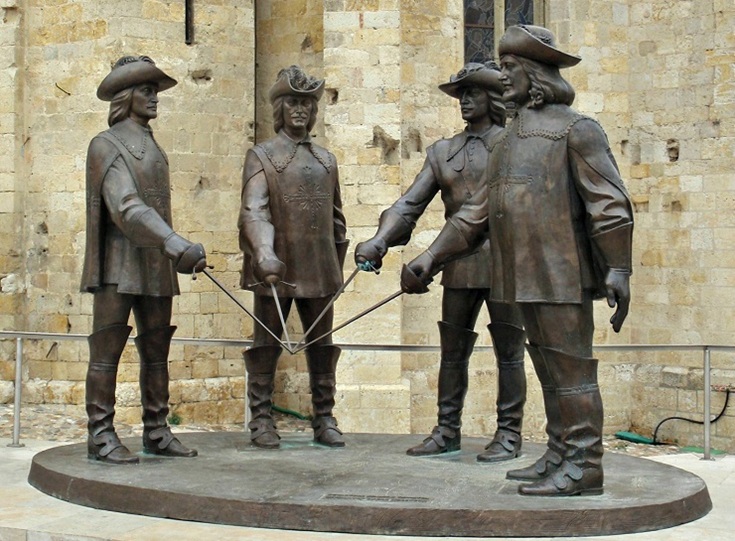
A statue in Condom immortalises D’Artagnan who is said to have lived here as a boy before leaving for a life of adventure with his companions Athos, Porthos and Aramis, or so the story goes…
It is possible to cover this 200-kilometre (125 mile) stage in eight or nine days by walking 20—25 kilometres (12—15 miles) each day and skipping the rest day…
Nine-day itinerary for Cahors to Éauze
Day 1 Cahors to Lascabanes (24.5 km/15.3 mi)
Day 2 Lascabanes to Lauzerte (23.5 km/14.7 mi)
Day 3 Lauzerte to Moissac (27 km/16.9 mi)
Day 4 Moissac to Auvillar (21 km/13.1 mi)
Day 5 Auvillar to Castet-Arrouy (22.3 km/13.9 mi)
Day 6 Castet-Arrouy to Marsolan (19 km/11.9 mi)
Day 7 Marsolan to Condom (23 km/14.4 mi)
Day 8 Condom to Montréal-du-Gers (17 km/10.6 mi)
Day 9 Montréal-du-Gers to Éauze (16 km/10 mi)
Look inside the CHEMIN DE SAINT-JACQUES DU-PUY (PDF) guidebook
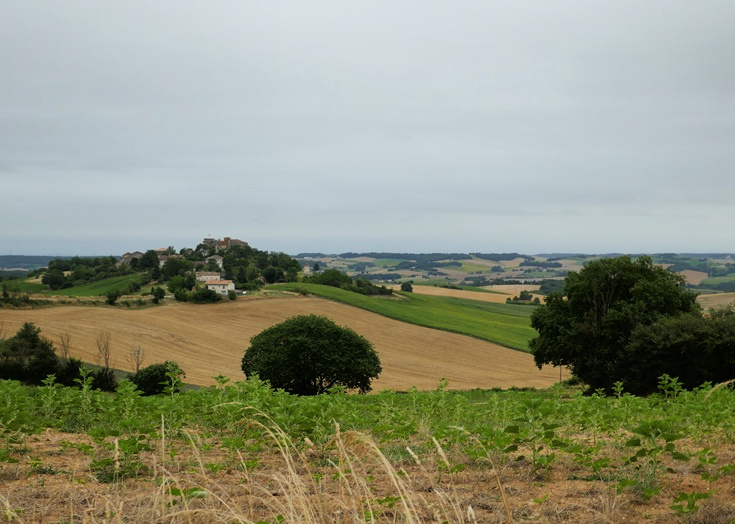
Fields around the hilltop village of Flamarens, ready for planting with wheat, corn or sunflowers
The best time of year to walk from Cahors to Éauze
Although most of the small hotels along this section are open throughout the year, many of the chambres d’hôtes and gîtes close from mid to late October, taking a well-earned break before reopening in late March or around Easter.
Early in the walking season, mornings and evenings can be cool and crisp, and wearing layered clothing which can be added and removed throughout the day works well in all conditions.
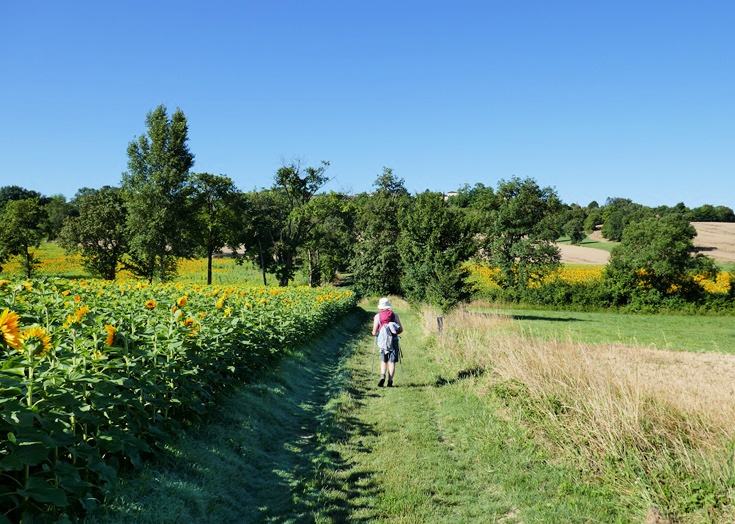
Close enough to touch – a field of sunflowers near Castelnau-sur-l’Avignon (photo taken in early July)
Summer temperatures can be quite high with the occasional 40-degree (Celsius) heatwave. In these conditions, carrying plenty of water and refilling your water bottle whenever you have the chance becomes a high priority. But as you walk south from Cahors, the summer sunshine will reward you with fields of sunflowers—a glorious sight, well worth any discomfort from the higher temperatures.
By September, temperatures begin to fall again and the milder weather is perfect for walking. The sunflowers, though, will be long past their best. Most of the fields will have been harvested, and only a few will be left to dry for seed collection.
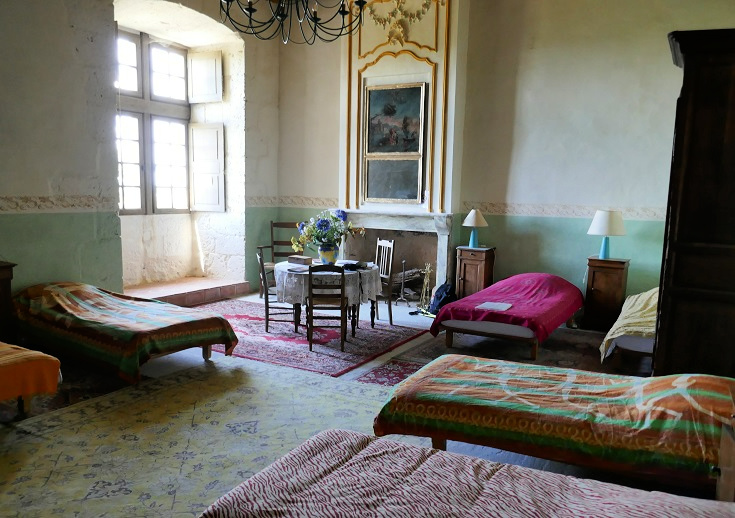
Overnight accommodation Château de Flamarens offers a glimpse into life inside a fortified château
Do I need to pre-book accommodation?
When it comes to pre-booking accommodation, most walkers fall squarely into one of two camps—those who always do, and those who can’t imagine why locking in your overnight stops in advance would be a good idea. When walking, I definitely fall into the first group, but many walkers set out each morning with little more than a vague plan and successfully find a bed each night.
In May and early June, many French walkers take advantage of a string of public holidays to make their vacation leave go further and head out for a week-long walk. In 2025, these days fall on 1 May (Labour Day), 8 May (Victory in Europe Day), 29 May (Ascension Day) and 9 June (Whit Monday) and accommodation can be tight during these weeks.
Mid-June through until late August is usually a quieter period and there is less demand for accommodation. Then, when school holidays finish in early September, many French grandparents are relieved of baby-sitting duties and once again, the chemin sees an increase in the number of older walkers seeking beds for the night.
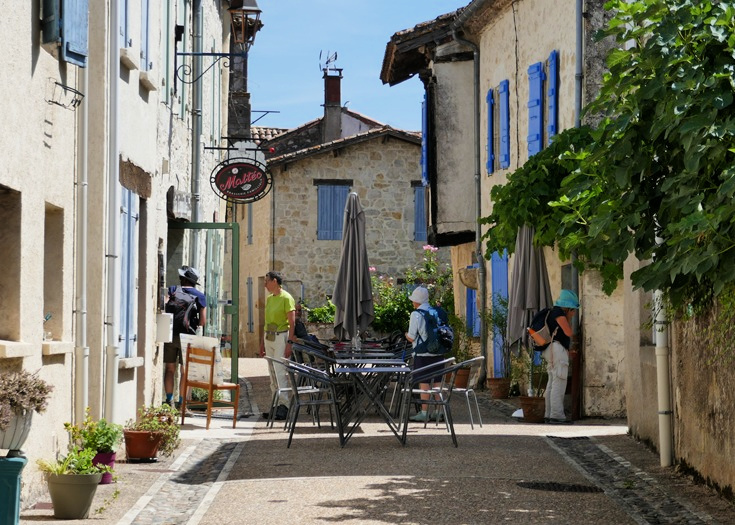
A café in the centre of Saint-Antoine offers a welcome chance to stop for lunch or a snack
If you started your walk in Le Puy-en-Velay and have been walking for several weeks now, you’ll have a good feel for how busy the path is and whether you need to book several days ahead or can wait until the morning before. Of the five stages I have broken this walk into, this stage from Cahors to Éauze usually feels the least crowded, and if ever I take the plunge and walk without my accommodation pre-booked, this is where I’ll do it. Of course, I may need to take my own advice and be more flexible with types of accommodation (the occasional more expensive hotel or more basic bunk bed dormitory) and distances walked (perhaps a longer or shorter day than I would prefer) in order to find a bed.
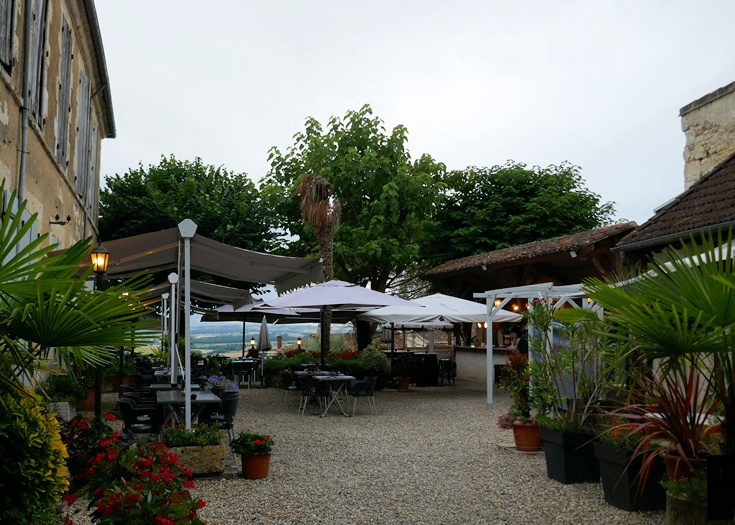
Restaurant Bellevue in Lectoure serves simple, hearty meals. Choose a table at the edge of the terrace for fabulous views across the valley.
If there is a particular village, hotel, chambre d’hôte or gîte that you’d like to stay at, I always recommend booking a bed as early as possible.
If you enjoy participating in the communal dinner each night, booking your room and dinner the day before gives your host time to prepare and is a courtesy that is always appreciated. And if you have any special dietary considerations, a few days’ notice may be the difference between a delightful meal and settling for trail mix.
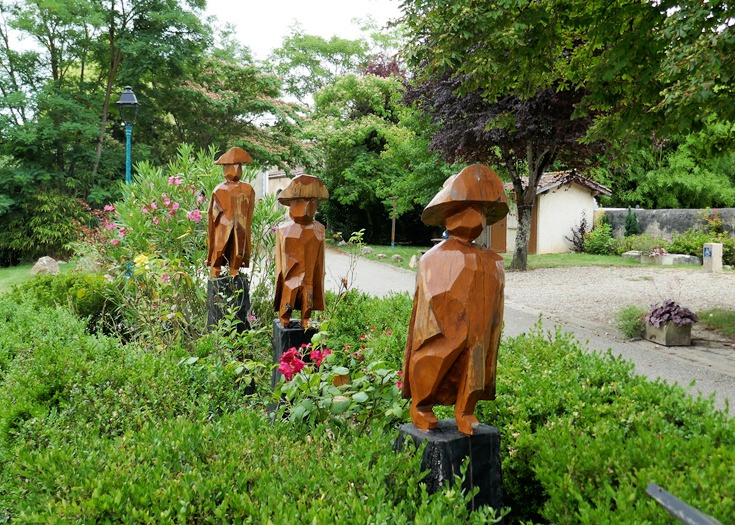
Luggage transfers
The Chemin de Saint-Jacques du-Puy is blessed with several companies who will transport your luggage on to your next destination. Make sure your bags meet all weight and size requirements, are clearly labelled and are in the foyer by 8am each morning. Your bag will be delivered to your accommodation (according to your booking instructions) later that day.
Be aware that transfer companies generally do not collect and deliver to accommodation that does not provide a secure place to leave luggage. If you book accommodation through a hotel booking website that provides access remotely via a code, you may need to make arrangements to have your bags delivered elsewhere.
Each of these companies has slightly different prices, weight limitations, and start and end of season dates. Check each one for the service that suits you best.
La Malle Postale (Le Puy-en-Velay to Aire-sur-l’Adour)
Transport Lample (Le Puy-en-Velay to Moissac)
Transports Claudine (Figeac to Saint-Jean-Pied-de-Port)
Les Valises de Saint-Jacques (Moissac to Saint-Jean-Pied-de-Port)
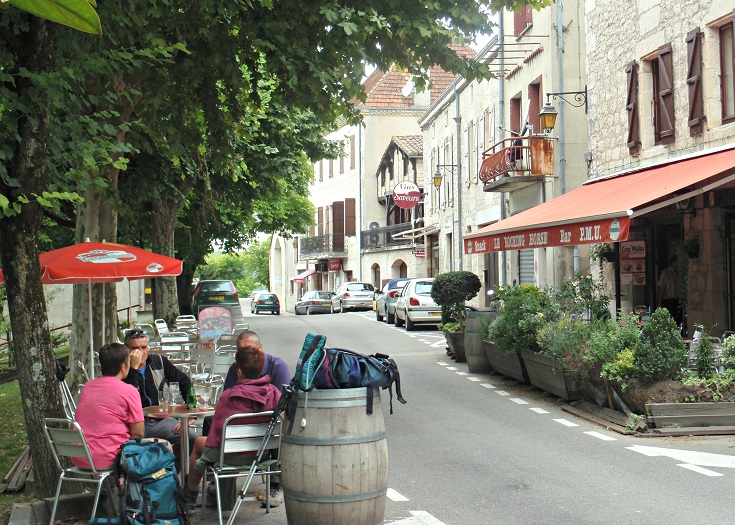
Walkers stop for a cold drink at Rocking Horse Bar in Montcuq
Transport options to and from Cahors
Train line Brive—Cahors—Toulouse connects Cahors to Brive-la-Gaillarde and Toulouse, both have daily train connections to Paris.
Lot bus line 889 will take you back to several villages on the Chemin de Saint-Jacques located between Cahors and Figeac including Faycelles, Cajarc, Saint-Cirq-Lapopie (Tour de Faure), Bouziès and Vers.
Lot bus line 875 operates on a limited summer schedule and connects Cahors with Montcuq and Lauzerte.
Lot bus line 882 runs on week days, connecting Cahors to Montcuq.
Transport options along the Chemin de Saint-Jacques
Several towns along this stage offer good entry and exit points to the Chemin de Saint-Jacques for those breaking their walk into stages.
Moissac—Train line Bordeaux—Agen—Toulouse connects Moissac with Bordeaux, Agen, Lamagistère, Valence-d’Agen, Castelsarrasin, Montauban and Toulouse. Each of these towns offer good sight-seeing opportunities and train connections to other parts of France.
Tarn-et-Garonne bus line 801 connects Moissac to Malause and Pommevic, both located close to the canal on the way to Auvillar.
Tarn-et-Garonne bus line 807 connects Moissac to Lauzerte.
Lectoure—Gers bus line 932 connects Lectoure to Auch and Agen, both have daily train connections to Paris.
Condom has daily bus connections to Auch (Gers bus line 951) and to Agen (Gers bus line 953). Auch and Agen both have daily train connections to Paris.
Transport options to and from Éauze
Public transport options to and from Éauze are more complicated but not impossible.
From Éauze, take Gers bus line 952 Nogaro—Condom to either town. This service also stops at Manciet, the next town continuing along the Chemin de Saint-Jacques.
At Condom, Gers bus line 953 Condom—Agen will take you to Agen which has daily train connections to Paris.
At Nogaro, Gers bus line 934 Auch—Aire-sur-l’Adour will take you to Auch (for daily train connections to Paris) and also to several towns along the next stage of the Chemin de Saint-Jacques including Manciet, Nogaro, Lanne-Soubiran, Luppé-Violles, Barcelonne-du-Gers and Aire-sur-l’Adour.
Find many more practical tips on preparation, packing, choosing a guidebook and avoiding blisters.
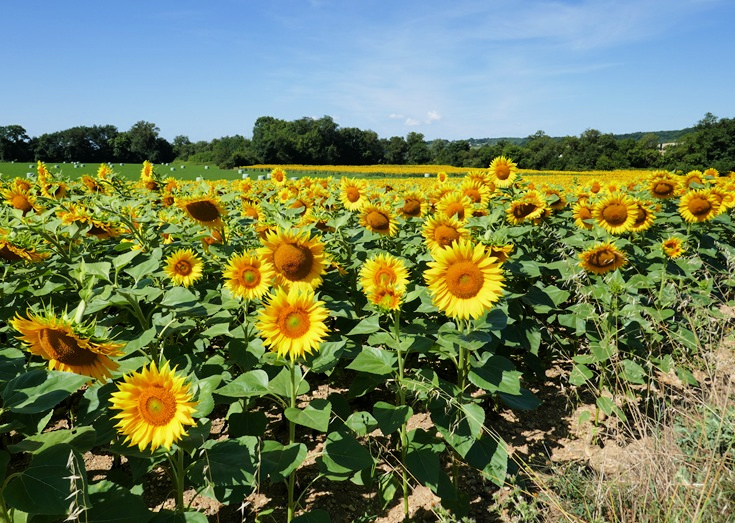
In 2022, the first sunflowers appeared on the path soon after Bardigues in late June, but in other years their cheerful faces have brightened the way as early as mid-June in Lascabanes.
Look inside the CHEMIN DE SAINT-JACQUES DU-PUY (PDF) guidebook
HIGHLIGHTS OF STAGE 4: CAHORS TO ÉAUZE
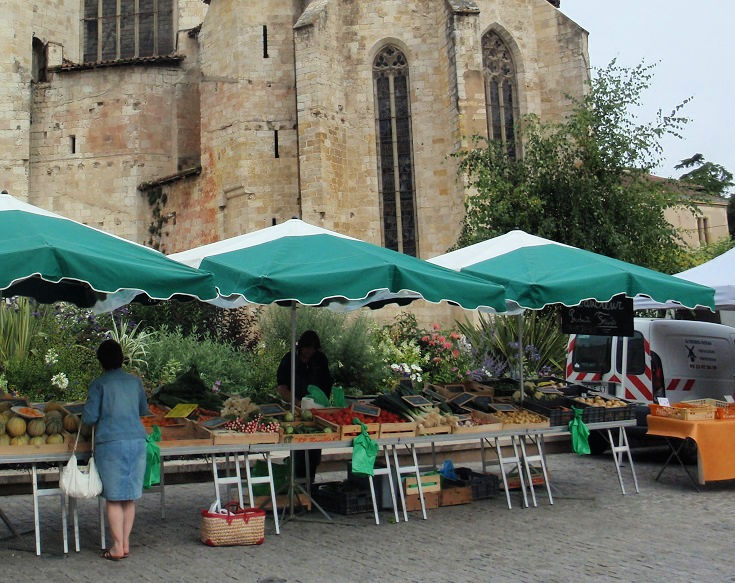
Wednesday morning market in Condom
Fresh food markets
You’ll find fresh food markets in full swing every day of the week (except Tuesday) somewhere between Cahors and Éauze. Chances are excellent that more than one of them will coincide with your visit so make the most of your good fortune and pack a picnic basket filled with delicious home-made produce.
Cahors—Wednesday and Saturday mornings
Montcuq—Sunday morning all year, Thursday morning in July and August
Lauzerte—Wednesday and Saturday mornings, Thursday evening in July and August
Moissac—Saturday and Sunday mornings
Auvillar—Sunday morning
Miradoux—Saturday morning
Lectoure—Friday morning all year, Monday evening in July and August
Condom—Wednesday, Saturday and Sunday mornings
Montréal-du-Gers—Friday morning
Éauze—Thursday morning

Pont Valentré, Cahors
Cahors
Cahors has occupied its position on a loop of the River Lot since Roman settlers arrived in the first century BC. Today, Boulevard Gambetta divides the town neatly down the middle—modern (nineteenth century) civic buildings to the west, and medieval splendour to the east.
Allow some time to explore the town, including the Cathedral dedicated to Saint-Étienne with its tranquil sixteenth-century cloister and the famous Pont-Valentré, built with the help of the devil (learn more at the link below).
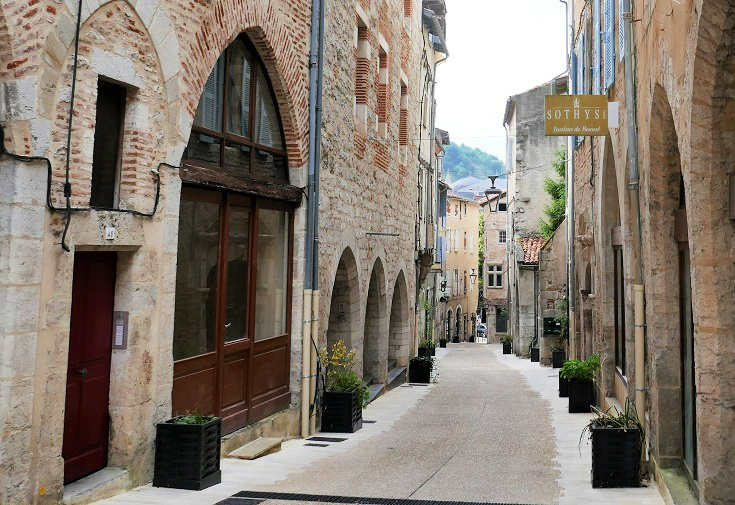
Some of the oldest houses in Cahors can be found strolling along Rue des Soubirous
Cahors is famous for its red wine, made primarily from Malbec grapes and supplemented with Merlot and Tannat. Production of the wine is governed by the AOC (Appellation d’Origine Controlée) which sets strict guidelines on care of the vines, soil and harvesting times and methods. Wines produced under these regulations depend greatly on the mercy of the sunshine and local rainfall and result in vintages which vary from year to year. But they all contain a large dose of love (and none of the chemicals which usually give me a headache!). If you have an afternoon to spare, ask at the Tourist Office about winery tours.
Take a closer look around Cahors and find a comprehensive list of accommodation.
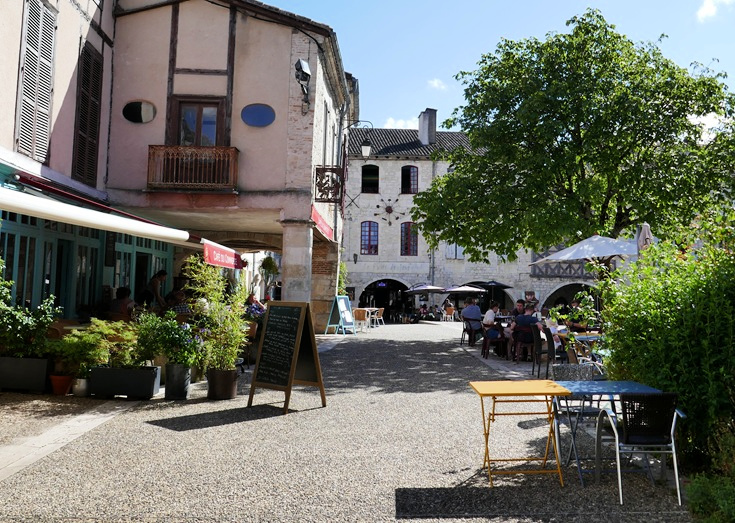
Place des Cornières in Lauzerte, with several cafés offering meals and drinks, is a popular meeting place for walkers each afternoon
Lauzerte
Towards the end of the twelfth century, two noblemen approached Raymond V, Count of Toulouse, with a proposal to build a château and 200 houses on a hill in the Quercy region. Protected by towers and six gates that controlled the entrance to the town, Lauzerte was the earliest version of the bastide, or fortified town, which provided a strategic defence post for the rulers of the time.
Sadly, the château is no longer standing, but the spectacular setting and charming alleys have long drawn artists to the village. Wander the streets passing galleries and workshops displaying local creations, then settle in at one of the many cafés on Place des Cornières for a refreshing cold drink.
Take a closer look around the ‘most beautiful village’ of Lauzerte and find a comprehensive list of accommodation.
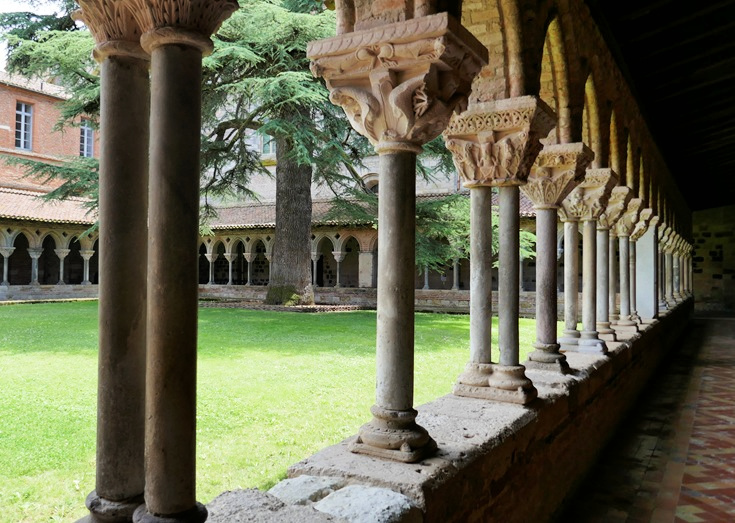
Seventy-six capitals adorning the columns lining the cloister in Moissac
Moissac
Three days after leaving Cahors, you’ll arrive in Moissac. If you find yourself looking forward to a rest day, then this beautiful town steeped in history is a good choice—particularly if your visit falls on the weekend when the markets are in full swing.
Be sure to set aside an hour or two to visit the cathedral and adjoining cloister. Audio guides, available from the Tourist Office behind the church, provide a detailed commentary of the architecture and the delicate carvings. The cloister was completed in 1100 and the seventy-six capitals adorning the columns are believed to be the oldest in the world.
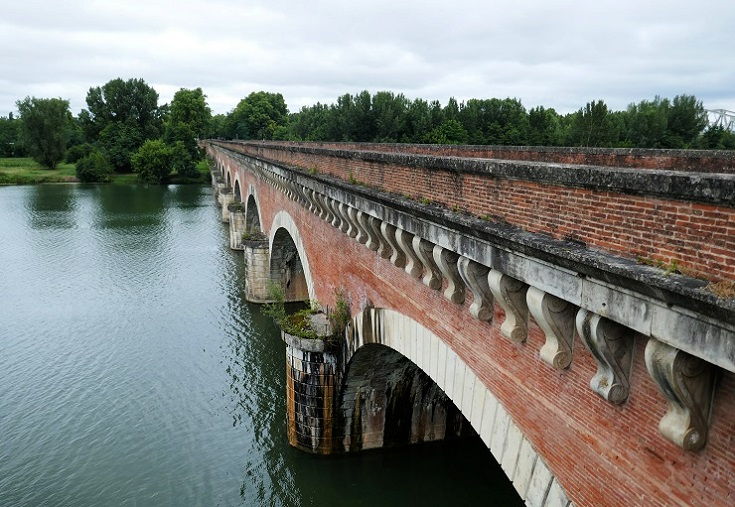
Follow the canal east from Moissac to where it forms a bridge over the river
As well as allowing your leg muscles some recovery time, a longer stay will enable you to climb the hill to the Carmelite Convent, and follow the canal a short way to the bridge crossing above the Garonne River—sights that are sometimes sacrificed in the interests of conserving energy or time.
Take a closer look around Moissac and find a comprehensive list of accommodation.
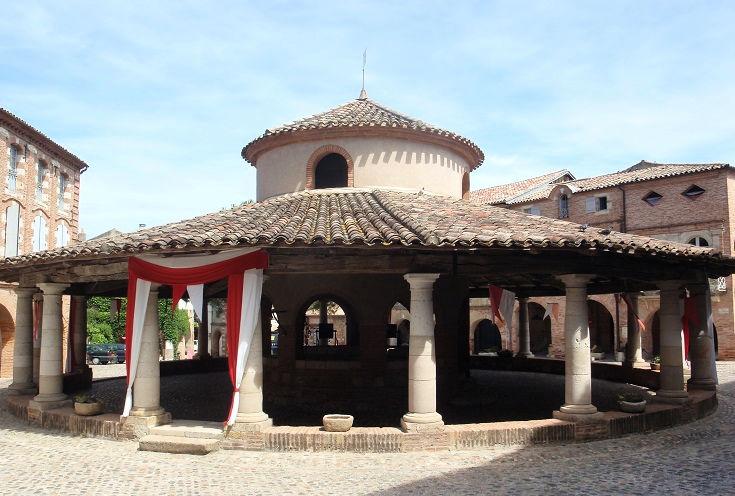
Halle Circulaire, Auvillar
Auvillar
The beautiful Halle Circulaire surrounded by a stone and timbered arcade in the centre of Auvillar is one of the best-known landmarks along the Chemin de Saint-Jacques. Join other walkers resting in the cool shade under its wide roof, then head over to the remains of the château where you’ll enjoy stunning views of the GR 65 path as it passes through Espalais.
Take a closer look around the ‘most beautiful village’ of Auvillar and find a comprehensive list of accommodation.
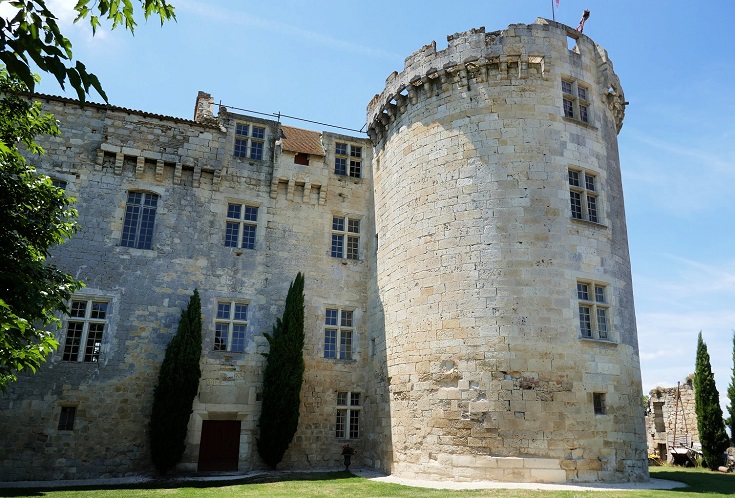
Château de Flamarens
Flamarens
Dominating the village of Flamarens is an imposing thirteenth-century château. At the end of the Hundred Years War in 1469, the château was enlarged and luxuriously decorated in a sumptuous display of wealth and prosperity. By the beginning of the twentieth century, the château was deserted and had fallen into disrepair, and in the summer of 1943, the roofs were destroyed when lightning ignited a fierce fire.
In 1983, the derelict château was bought by the Gadel family who have lovingly restored the lower floors and now offer overnight accommodation—which I can thoroughly recommend! (A double room is available in addition to two six-bed rooms.)
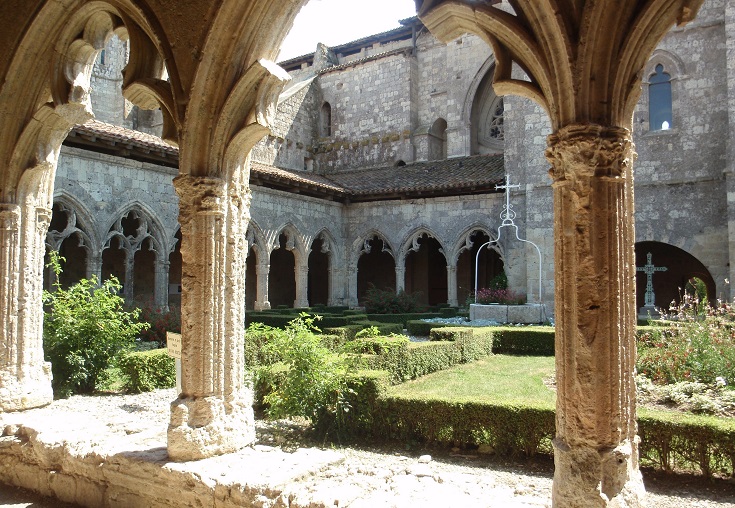
Cloister in La Romieu
La Romieu
A highlight of this section of the Chemin de Saint-Jacques is the UNESCO-listed, fourteenth-century church and cloister in La Romieu. Although a fire destroyed the wooden upper floors of the cloister in 1569 during the Wars of Religion, the delicate stonework of the ground floor arches remains, and frames the lovely garden beds in the centre of the cloister.
From inside the church, it is possible to climb the spiral stone staircase in one of the adjoining towers and enjoy the glorious views over the countryside.
Take a closer look around the ‘most beautiful village’ of La Romieu and find a comprehensive list of accommodation.
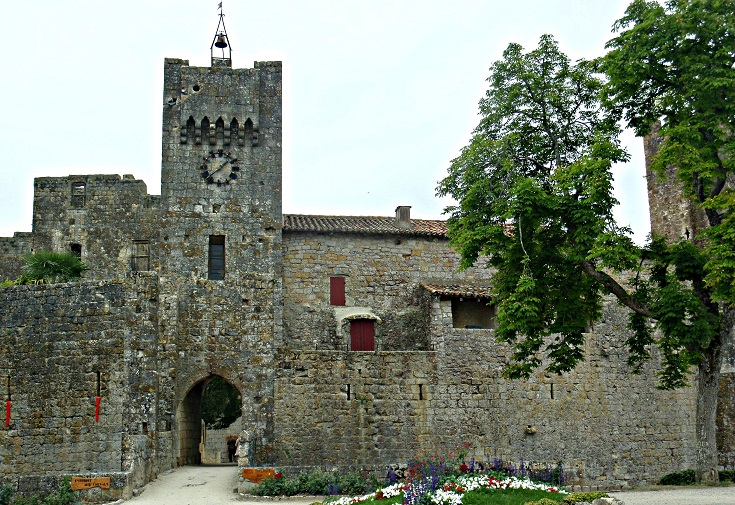
Entrance to the walled village of Larressingle
Larressingle
Located one-kilometre (or a fifteen-minute walk) from the path, the thirteenth-century fortified village survived the Hundred Years War and the Wars of Religion but was almost lost to decades of neglect. Thankfully, an Italian Duke fell in love with the stone towers and dry moat and raised funds for its restoration! Today, the village is listed among France’s ‘most beautiful villages’!
Arrive in time to linger over lunch in the shadow of the stone towers, then head into any of the gift shops for a glimpse inside the walls.

Place de l’Hôtel de Ville, Montréal-du-Gers
Montréal-du-Gers
Founded in 1255, Montréal-du-Gers was the first of the bastides, or fortified villages built in the Gers region of France. Despite the fortifications, the village was lost to the English in battle, and reclaimed, several times over the next three centuries.
Ask at the Tourist Office for a map of the town which outlines a short walk around the village, passing the central arcade, quaint alleys and covered walkways.
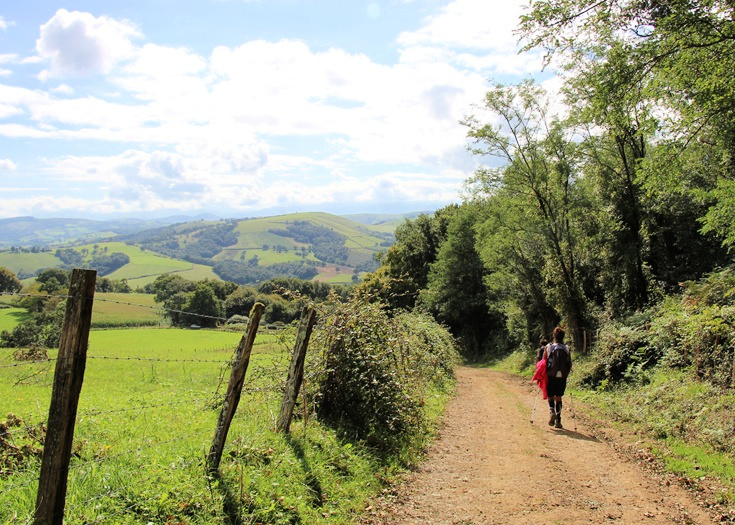
Stage 5 from Éauze to Saint-Jean-Pied-de-Port leads towards the majestic mountains of the Pyrénées
From Cahors, continue on to the final section of the Chemin de Saint-Jacques du-Puy
Stage 1: Le Puy-en-Velay to Aumont-Aubrac
Stage 2: Aumont-Aubrac to Figeac
Stage 3: Figeac to Cahors
Stage 4: Cahors to Éauze
Stage 5: Eauze to Saint-Jean-Pied-de-Port
Ready to plan your walk along the Chemin de Saint-Jacques du-Puy?
Purchase the Chemin de Saint-Jacques (PDF) guidebooks
Purchase five guidebooks covering Le Puy-en-Velay to Saint-Jean-Pied-de-Port
Look inside the CHEMIN DE SAINT-JACQUES DU-PUY (PDF) guidebook
